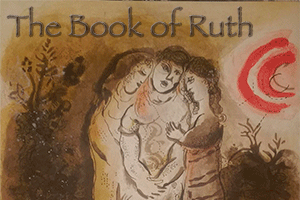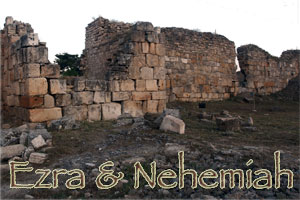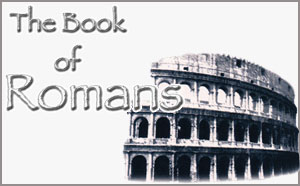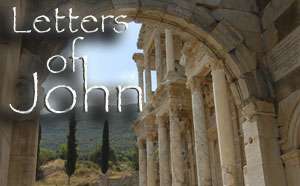Lessons
Genesis, which means “beginning”, is the first book of the Bible. God speaks and the world is created.
He brings order and beauty out of chaos in His creation. Genesis pictures how humans reintroduce chaos. Modern readers will identify with the conflicts that result and discover God’s plan to provide the redemption that is so needed.
Genesis strongly affirms that God is not only creator of the universe but sustainer as well. He continues to speak so that humans, whom He formed in His very own image, are counseled, comforted and provided for. God’s desire has always been that people would walk with Him so that He could richly bless them. A study of Genesis is an opportunity to walk with God and receive His blessing.
Exodus is the story of God coming to dwell with His people who exchange slavery in Egypt for worship of God. During years of wilderness wandering the people are led by Moses, a friend of God, who models deep faith and wise leadership.
Exodus is the continuation of a narrative running from Genesis through Deuteronomy. God fulfills promises made to their fathers. He reveals His power, gives the law (including the Ten Commandments), instructs in worship and provides His presence. The book of Exodus is a compelling picture of God and His work. It provides a foundation for all that unfolds in redemption history and ultimately finds fulfillment in Christ.
Those who seek to experience the presence of God or struggle in places of wilderness wandering will find faith enlarged as they study this book.
Is there hope beyond famine, loss of family members and life as displaced people? The Hebrew short story of Ruth says, “YES”. Empty people with broken lives can be filled and redeemed by a gracious God.
The widowed Moabitess, Ruth, makes a life-changing promise to her bereft Mother-in-law Naomi. “Where you go I will go, and where you stay I will stay. Your people will be my people and your God will be my God.” Leaving her homeland and family in Moab, Ruth returns with Naomi to Israel. In the faithful living out of her promise she comes to know the tender mercy of Boaz, a man of great character and kindness. He welcomes her to work in his fields and eventually becomes her husband. It is through this marriage that Ruth, the foreigner, becomes great-grandmother of David and part of Christ’s genealogy.
A remarkable account of lament turned to praise, Ruth, challenges God’s people today to wider mercy for aliens and strangers, deeper trust in difficult seasons of life, and fresh praise for God’s faithfulness throughout generations.
The books of first and second Samuel contain the stories of God’s work in the lives of real people. From the fervent prayer of barren Hannah, to the anguished confession of King David, they record human longings, failures and frailties in ways that sometimes uncomfortably mirror our own lives. They also show God’s amazing grace at work in the lives of His people, transforming them and using even their failures to rebuild their lives and achieve His ultimate purposes.
The books chronicle the transition of a group of tribal people led by “judges” to a nation ruled by a human king under God. Along the way their journey is marred by battles and defeats, disloyalty and despair. However, they are sustained by a gracious God who rules in true wisdom and power.
God has not changed. The message of the books, as well as the call to be under the kingship of God, is as relevant today as it was then.
Ezra and Nehemiah detail the return of the Jews to Jerusalem from their Babylonian captivity. Ezra begins with the surprising decree from Cyrus that permits captive Jews “to go up to Jerusalem… and rebuild the house of the Lord.” Can exiles, seeped in a pagan culture, return to a life of religious purity? Will they have the skills to rebuild a temple and a wall? Will their leaders be strong enough to withstand the enemies within and without?
While some might focus on the rebuilding of the temple and walls of Jerusalem in these books, accomplished in spite of great hardship and opposition, the rebuilding of a spiritual community is of even greater significance. Wise and godly leaders Ezra and Nehemiah challenge the returned exiles to reclaim an identity as the people of God.
An understanding of that identity grows as they work sacrificially alongside one another, as they worship together and as they embrace the words of scripture with repentance and obedience. They are always in danger without these practices.
Ezra and Nehemiah remind discouraged leaders and rebuilders that God is in the restoration business. His gracious hand rests upon all those who seek to faithfully build His kingdom.
Ezra and Nehemiah detail the return of the Jews to Jerusalem from their Babylonian captivity. Ezra begins with the surprising decree from Cyrus that permits captive Jews “to go up to Jerusalem… and rebuild the house of the Lord.” Can exiles, seeped in a pagan culture, return to a life of religious purity? Will they have the skills to rebuild a temple and a wall? Will their leaders be strong enough to withstand the enemies within and without?
While some might focus on the rebuilding of the temple and walls of Jerusalem in these books, accomplished in spite of great hardship and opposition, the rebuilding of a spiritual community is of even greater significance. Wise and godly leaders Ezra and Nehemiah challenge the returned exiles to reclaim an identity as the people of God.
An understanding of that identity grows as they work sacrificially alongside one another, as they worship together and as they embrace the words of scripture with repentance and obedience. They are always in danger without these practices.
Ezra and Nehemiah remind discouraged leaders and rebuilders that God is in the restoration business. His gracious hand rests upon all those who seek to faithfully build His kingdom.
The Gospel of Matthew presents Jesus as the one who came as Messiah and King. Written in the first century to a Jewish audience who yearned for such a savior, it attempts to establish Jesus as a Jew descended from David who would reign forever. The gospel links together the Old and the New Testament showing Christ as the fulfillment of prophecy.
Jesus came not to abolish the law but to fulfill it. He taught that the most important call on one’s life was to “Love the Lord your God with all your heart, and with all your soul and with all your mind and to love your neighbor as yourself.” In five great discourses woven throughout the gospel he helped his audience grasp what this means. For contemporary readers, obedience to these commands does not only lead to the transforming love so desperately needed in our world, but to the fruits of peace and joy.
The gospel of Mark introduces us to the life and teachings of Jesus with a fast-paced narrative. It is believed to have been written between 50-65AD. Overlooked for years by biblical scholars because of its brevity, it has gained great significance since its recognition as the first gospel written and as the source material for Matthew and Luke.
John Mark was a Roman citizen whose Christian mother, Mary, lived in Jerusalem and whose cousin Barnabas was Paul’s traveling companion. Mark was not one of the twelve disciples but was a follower of Jesus. He was also a close companion of Peter and is believed to have drawn heavily on Peter’s preaching in the shaping of his gospel. Some scholars have even suggested that the book could be called “the gospel of Peter as told by Mark”.
The book was written to encourage Romans living in a time of great hardship. The early church struggled with internal tension between Jewish and Gentile believers. It also suffered great persecution in which some believers were martyred and others reduced to living in the catacombs. Mark’s gospel provides comfort in a presentation of Jesus not only as powerful Son of God but also as compassionate and suffering Servant. Whether readers come to this gospel for the first time or return after many visits, they will be amazed at the grace and power of Jesus Christ who still changes lives.
![]()
Leon Morris compared John’s Gospel to a “pool in which a child may wade and an elephant can swim.” The Gospel speaks to those inquiring about Christian faith as well as to those who have embraced it. Years of close study of this Gospel will not leave one with the feeling of having mastered it.
John summed up his purpose for writing the Gospel by saying: “These things are written that you may believe that Jesus is the Christ, the Son of God, and that by believing you may have life in his name” (John 20:31). Christ’s miracles, his words and the testimony of witnesses who knew him are used by John to prove his deity.
Matthew wrote for the Jews, Mark for the Romans, and Luke for the Greeks. John had the whole world in mind when he wrote and frequently used the word world. But he alludes to the Old Testament over one hundred times, showing that he was mindful of his Jewish readers.
The Gospel of John invites us to come and see that Jesus is indeed the Son of God and Savior of the world.
Leon Morris compared John’s Gospel to a “pool in which a child may wade and an elephant can swim.” The Gospel speaks to those inquiring about Christian faith as well as to those who have embraced it. Years of close study of this Gospel will not leave one with the feeling of having mastered it.
John summed up his purpose for writing the Gospel by saying: “These things are written that you may believe that Jesus is the Christ, the Son of God, and that by believing you may have life in his name” (John 20:31). Christ’s miracles, his words and the testimony of witnesses who knew him are used by John to prove his deity.
Matthew wrote for the Jews, Mark for the Romans, and Luke for the Greeks. John had the whole world in mind when he wrote and frequently used the word world. But he alludes to the Old Testament over one hundred times, showing that he was mindful of his Jewish readers.
The Gospel of John invites us to come and see that Jesus is indeed the Son of God and Savior of the world.
The story of Acts begins in Jerusalem, the center of the Jewish nation, and ends in Rome, the center of the Gentile world. The essence of Acts is the movement of the Holy Spirit continuing what Jesus began to do in His earthly ministry.
Before Jesus ascended into heaven he said to His disciples: “You will receive power when the Holy Spirit comes on you; and you will be my witnesses in Jerusalem, and in all Judea and Samaria, and to the ends of the earth.” Acts 1:8
The early disciples were empowered by the Holy Spirit to go as witnesses to the ends of the earth with the good news of the resurrected Jesus. The communities that formed as the result of their witness became the living body of Christ, known as the church. Characterized by both faith and failure, the early church provides important lessons for contemporary believers. This body of Christ remains God’s vehicle for dispensing grace and truth until the Lord’s return.
“This Epistle is really the chief part of the New Testament and the very purest Gospel, and is worthy not only that every Christian should know it word for word, by heart, but occupy himself with it every day, as the daily bread of the soul. It can never be read or pondered too much, and the more it is dealt with the more precious it becomes, and the better it tastes…
Thus in this Epistle we find most richly the things that a Christian ought to know; namely, what is law, Gospel, sin, punishment, grace, faith, righteousness, Christ, God, good works, love, hope, the cross, and also how we are to conduct ourselves toward everyone, whether righteous or sinner, strong or weak, friend or foe. All this is ably founded on Scripture and proved by his own example and that of the prophets. Therefore it appears that St. Paul wanted to comprise briefly in this one Epistle the whole Christian and evangelical doctrine and to prepare an introduction to the entire Old Testament; for, without doubt, he who has this Epistle well in his heart, has the light and power of the Old Testament with him. Therefore let every Christian exercise himself in it habitually and continually. To this may God give His grace. Amen.”
Taken from Martin Luther’s Commentary on Romans (1552)
The apostle Paul was a prisoner when he wrote these letters to the early church. They reveal great freedom and joy in spite of adversity. The key for Paul was “life in Christ,” a life of true freedom. For Paul, nothing compared to the surpassing greatness of knowing Christ Jesus his Lord. He yearned for everyone to share his joy.
These Prison Letters contain, much as Dietrich Bonhoeffer’s prison writing generations later do, great insights about the supremacy of Christ, the cost of discipleship and the importance of living together in community. They are filled with thanksgiving. They are laced with prayers that encourage people of all generations to live as visible expressions of God’s grace in the world. They invite today’s readers to “put into practice” much that will lead to true peace and freedom.
The theme of Ephesians is unique among all His letters. It is the theme of the nature of the true church, the body of Christ.
The apostle Paul was a prisoner when he wrote these letters to the early church. They reveal great freedom and joy in spite of adversity. The key for Paul was “life in Christ,” a life of true freedom. For Paul, nothing compared to the surpassing greatness of knowing Christ Jesus his Lord. He yearned for everyone to share his joy.
These Prison Letters contain, much as Dietrich Bonhoeffer’s prison writing generations later do, great insights about the supremacy of Christ, the cost of discipleship and the importance of living together in community. They are filled with thanksgiving. They are laced with prayers that encourage people of all generations to live as visible expressions of God’s grace in the world. They invite today’s readers to “put into practice” much that will lead to true peace and freedom.
The church at Philippi was not troubled by serious doctrinal problems, only by the problems of everyday life. Paul wrote this letter as a guide for ordinary living–how to live with joy in the midst of the normal difficulties of life.
The apostle Paul was a prisoner when he wrote these letters to the early church. They reveal great freedom and joy in spite of adversity. The key for Paul was “life in Christ,” a life of true freedom. For Paul, nothing compared to the surpassing greatness of knowing Christ Jesus his Lord. He yearned for everyone to share his joy.
These Prison Letters contain, much as Dietrich Bonhoeffer’s prison writing generations later do, great insights about the supremacy of Christ, the cost of discipleship and the importance of living together in community. They are filled with thanksgiving. They are laced with prayers that encourage people of all generations to live as visible expressions of God’s grace in the world. They invite today’s readers to “put into practice” much that will lead to true peace and freedom.
The Colossian Christians were on the verge of losing their understanding of the power by which the Christian life is lived. this letter is Paul’s great explanation of the power and joy that God provides for living the Christian life.
![]()
Paul, along with Timothy and Silas, helped establish the Thessalonian church on the second missionary journey. When they were forced to flee Thessalonica, they left a body of believers facing persecution. Wrenched too soon from beloved new friends, they sent letters back to them.
The Thessalonian letters, among the earliest in the New Testament, are filled with loving encouragement. Paul commends the young church for standing firm in the face of adversity. He commends their reputation for love and faithfulness. He urges them to continue in that.
Paul’s letters present the hope of Christ’s return with teaching about the end times.
God’s people will be delivered and the wicked will be judged. God’s victory over evil will be complete. No one is to get tired of doing what is right as they wait for that day.
Paul reminds his readers that the community of the beloved Savior is worth working in and working for. The Lord Jesus Christ himself is the one who is able to encourage hearts and strengthen people in all times and all places to choose a life of purity and passion in Him.
![]()
In a brief letter written to a broad audience, James seeks to encourage people to live out an authentic faith in Christ. It is not enough to hear a word or see a truth as in a mirror. Something must be done about it.
The teachings in James draw deeply from those of Jesus and especially parallel the Sermon on the Mount. They challenge readers to persevere through trials with joy, resist temptation, love sacrificially, pray diligently, handle money wisely, speak graciously and grow always in wisdom. None of this is easy. But is there anyone who cannot benefit from such practices? Is there a family, a community, a church that would not benefit from lives lived with such maturity and wisdom?
James ends his letter with a challenge to “bring back sinners who wander from the truth.” Perhaps his letter does that for each thoughtful reader.
Written to a scattered and persecuted church, the letters of 1&2 Peter challenge them to godly living. While Peter urges his readers to practice costly obedience he also comforts them with reminders of all the benefits they enjoy as God’s chosen people.
In His first letter, Peter equips the believers to love well and overcome the dangers that arise from the pagan culture without. In his second letter he confronts the danger of false teachers and evildoers within the church.
The words of this faithful pastor and shepherd continue to encourage people to grow in the grace and knowledge of Christ. It is the witness of such people that shines light into the world’s darkness.
The three letters of John were written by a mature disciple who was dramatically transformed by his encounter with Jesus Christ. John was a young man when he began following Christ. His temper earned him the nickname “Son of Thunder” Ultimately the “Son of Thunder” became the ”Apostle of Love.” As an eyewitness of Christ’s ministry, the apostle John proclaimed in these letters what he had seen and heard of Christ so a conflicted early church might not be led astray.
In a day not unlike ours, when captivating teachers expounded compelling new ideas, he warned his readers that Christ alone is the true source of life and love. Christ’s love is always to overflow in our lives. As Christ’s dear children we are to love not with words or but with actions, guided by truth.
John writes these letters from the perspective of an aged saint who has learned what really matters. His first letter counters the temptation to embrace false teaching, to love the world, or to practice religion not rooted in genuine and sacrificial love. The second letter encourages truth and the separation from those who refuse to embrace the truth. The third addresses a threat to the church of a person who loved to be first.
All of John’s letters encourage the followers of Christ to know and love the truth, and to walk in it. John had no greater joy than hearing from those who chose this life. You are encouraged to join the host of followers whose lives have been transformed and whose faith has been deepened through study of these lovesoaked letters.






































